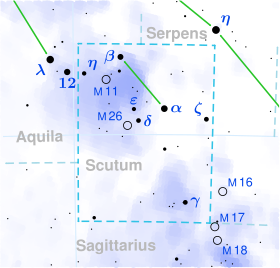
| |
| Observation data Epoch J2000 Equinox J2000 | |
|---|---|
| Constellation | Scutum |
| Right ascension | 18 43 31.251 |
| Declination | −8° 16′ 30.77″ |
| Apparent magnitude (V) | 4.88 |
| Characteristics | |
| Spectral type | G8IIb |
| U−B color index | +0.88 |
| B−V color index | +1.12 |
| Astrometry | |
| Radial velocity (Rv) | −9.8±0.6 km/s |
| Proper motion (μ) | RA: +21.781 mas/yr Dec.: +4,591 mas/yr |
| Parallax (π) | 5.7100 ± 0.1842 mas |
| Distance | 570 ± 20 ly (175 ± 6 pc) |
| Absolute magnitude (MV) | -1.18 |
| Details | |
| Luminosity | 403 L☉ |
| Surface gravity (log g) | 1.00 cgs |
| Temperature | 4,500 K |
| Metallicity | +0.05 dex |
| Rotational velocity (v sin i) | 5.1 km/s |
| Other designations | |
| ε Sct, 3 Aquilae, BD−08°4686, FK5 702, GC 25610, HD 173009, HIP 91845, HR 7032, SAO 142546, ADS 11601, CCDM J18435-0817A, WDS J18435-0817A, GSC 05692-02504 | |
| Database references | |
| SIMBAD | data |
Epsilon Scuti, Latinized from ε Scuti, is a probable astrometric binary star system in the constellation Scutum. It is faintly visible to the naked eye with an apparent visual magnitude of +4.88. Based upon an annual parallax shift of 5.71 mas as seen from Earth,> it is located approximately 570 light years from the Sun. It is moving closer to the Sun with a radial velocity of −9.8 km/s. Epsilon Scuti was a latter designation of 3 Aquilae.
The visible component is a yellow-hued bright giant with a G-type bright giant It is radiating 403 times the Sun's luminosity from its photosphere at an effective temperature of 4,500 K. Epsilon Scuti has at least three faint visual companions, two 14th magnitude stars, B and D, separated from the primary by 13.6 and 15.4 arcseconds respectively, and the 13th magnitude C, which is 38 arcseconds away.
References
- ^ Vallenari, A.; et al. (Gaia collaboration) (2023). "Gaia Data Release 3. Summary of the content and survey properties". Astronomy and Astrophysics. 674: A1. arXiv:2208.00211. Bibcode:2023A&A...674A...1G. doi:10.1051/0004-6361/202243940. S2CID 244398875. Gaia DR3 record for this source at VizieR.
- ^ Anderson, E.; Francis, Ch. (2012). "XHIP: An extended hipparcos compilation". Astronomy Letters. 38 (5): 331. arXiv:1108.4971. Bibcode:2012AstL...38..331A. doi:10.1134/S1063773712050015. S2CID 119257644. Vizier catalog entry
- ^ Keenan, Philip C.; McNeil, Raymond C. (1989). "The Perkins catalog of revised MK types for the cooler stars". The Astrophysical Journal Supplement Series. 71: 245. Bibcode:1989ApJS...71..245K. doi:10.1086/191373.
- Mermilliod, J. C. (2006). "VizieR Online Data Catalog: Homogeneous Means in the UBV System (Mermilliod 1991)". VizieR On-line Data Catalog: II/168. Originally Published in: Institut d'Astronomie. 2168. Bibcode:2006yCat.2168....0M.Vizier catalog entry
- Mallama, A. (2014). "Sloan Magnitudes for the Brightest Stars". The Journal of the American Association of Variable Star Observers. 42 (2): 443. Bibcode:2014JAVSO..42..443M.Vizier catalog entry
- ^ Gontcharov, G. A. (2006). "Pulkovo Compilation of Radial Velocities for 35 495 Hipparcos stars in a common system". Astronomy Letters. 32 (11): 759–771. arXiv:1606.08053. Bibcode:2006AstL...32..759G. doi:10.1134/S1063773706110065. S2CID 119231169.
- ^ Soubiran, Caroline; Le Campion, Jean-François; Brouillet, Nathalie; Chemin, Laurent (2016). "The PASTEL catalogue: 2016 version". Astronomy & Astrophysics. 591: A118. arXiv:1605.07384. Bibcode:2016A&A...591A.118S. doi:10.1051/0004-6361/201628497. S2CID 119258214.
- De Medeiros, J. R.; Mayor, M. (1999). "A catalog of rotational and radial velocities for evolved stars". Astronomy and Astrophysics Supplement Series. 139 (3): 433. arXiv:astro-ph/0608248. Bibcode:1999A&AS..139..433D. doi:10.1051/aas:1999401. Vizier catalog entry
- Eggleton, P. P.; Tokovinin, A. A. (September 2008), "A catalogue of multiplicity among bright stellar systems", Monthly Notices of the Royal Astronomical Society, 389 (2): 869–879, arXiv:0806.2878, Bibcode:2008MNRAS.389..869E, doi:10.1111/j.1365-2966.2008.13596.x, S2CID 14878976.
- Wagman, M. (August 1987). "Flamsteed's Missing Stars". Journal for the History of Astronomy. 18 (3): 212. Bibcode:1987JHA....18..209W. doi:10.1177/002182868701800305. S2CID 118445625.
- Mason, Brian D.; Wycoff, Gary L.; Hartkopf, William I.; Douglass, Geoffrey G.; Worley, Charles E. (2001). "The 2001 US Naval Observatory Double Star CD-ROM. I. The Washington Double Star Catalog". The Astronomical Journal. 122 (6): 3466. Bibcode:2001AJ....122.3466M. doi:10.1086/323920. Vizier catalog entry
| Constellation of Scutum | |||||||
|---|---|---|---|---|---|---|---|
| Stars |
| ||||||
| |||||||
| Star clusters |
| ||||||
| |||||||